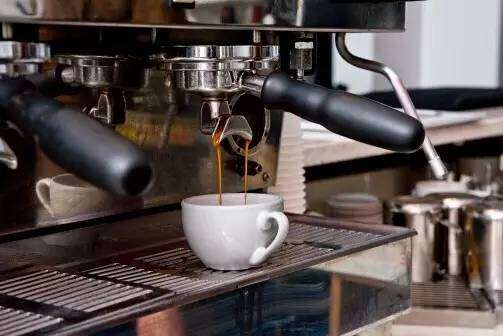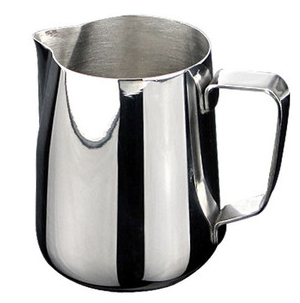The historical origin, several classifications, frequently asked questions and explanation of using skills of coffee machine
The history of coffee machines:
The Historical stage of the Development of Coffee machines: incubation period before 1900 the perfect Steam Theory of Coffee extraction in 1818, Dr. Romershausen obtained a patent for an "extractor" in Prussia. In 1822, the Frenchman Louis Bernard Rabout obtained a patent to obtain a cleaner extract based on the characteristics of oil-absorbing ink paper combined with the design of Dr. Romershausen. In 1824, Caseneuve, a Parisian craftsman, designed a coffee utensil that was too complex to make, hoping to avoid the loss of aroma. In 1827, Laurens's patent in France emphasized the need to wet coffee powder with steam before coffee extraction. In 1833, Samuel Parker, an Englishman, invented using a pump to pump water up through coffee instead of letting it flow down. (he paid special attention to the fact that the good taste of coffee first appeared bitter and was extracted in the later stage.) In 1838, Leburn, an optician in Paris, designed a number of small table coffee makers, which were very popular in southern Europe. In 1840, Tiesset designed a vacuum pump to pull hot water down with extra force through coffee powder. In 1844, Frenchman Cordier painted a number of coffee extractors in his patent, one of which was very similar to Eicke's German machine 30 years later. In 1847, Romershausen made a steam pressure coffee pot. In 1855, the Frenchman Loysel introduced a large-capacity bar coffee machine (about 4.5m high), which claims to make 10000 cups of coffee a day. In 1868, the Viennese Reiss developed a new type of "Viennese pot".
In 1885, the Italian Angelo Moriondo signed a patent for coffee that could make 50 cups at a time. Exclusive privilege of one cup of coffee from 1901 to 1947 A coffee machine designed by Luigu Bezzera in 1901 was successfully patented. In 1902, his friend Desiderio Pavoni added a pressure relief piston device to the machine and commercialized the machine for production and sale. In 1903, Bezzern sold the patent to Pavoni at a cost of 10, 000 lire due to financial difficulties. In 1905, La Pavoni Company was announced. In 1906, the Italian Arduino applied for a patent to install a heat exchanger in the machine to heat the water quickly. In 1909, Luigi Giarlotto added a pump to the machine to solve the problem of insufficient pressure in the extraction. In 1910, his second patent was the screw-down piston, which squeezed out all the delicacies of coffee from the piston. In 1935, Dr. Illy invented the first machine to use compressed air to push water through coffee powder. Since 1938, the placement of the boiler has been successfully improved from the original vertical to horizontal. Puberty 1948-1961 pressure increases and water temperature drops; the birth of the "gold bubble" in 1948, Gaggia introduced the piston lever spring coffee machine to the market. In 1952, the large vertical machine disappeared overnight. In 1956, Cimbali used hydraulic systems to avoid consuming too much effort when using levers. The popularization of electronic components after 1962; the advantage of "heat exchange, heat cycle" in 1955, Giampietro Saccani took an important step to maintain the stability of the temperature of the cooking head. In 1961, Italy and Spain jointly produced the E61 model. In the past, hot water was pressurized, but now it is pressurized and then heated, which is a perfect revolution compared to the past.
Different types of coffee machines are classified:
1. Semi-automatic coffee machine, commonly known as moving sub-machine, is a traditional Italian coffee machine. This kind of machine is operated manually to grind powder, press powder, load powder, brew and remove residue manually. These machines include small household machines with single faucets, large commercial machines with double faucets and three faucets, etc., and the newer machines are also equipped with electronic water control, which can accurately and automatically control the amount of coffee brewing. This kind of machine is mainly produced in Italy and is very popular in Italy. Its main features are: the machine is simple in structure, easy to work, easy to maintain, and high quality Italian coffee can be made according to the correct method of use. The disadvantage of this kind of machine is that operators have to be strictly trained to make high-quality coffee with this machine, and it is not easy to maintain the consistency of coffee quality. In addition, the efficiency of this kind of machine is relatively low.
two。 Full-automatic coffee machine, fixed mode, the coffee is only light, medium, strong, directly grind coffee beans and produce coffee, the new milking machine is inhaled, the advantage is fast and convenient, and the quality of the coffee is fixed. Nothing has changed. If you want to buy the best quality, but also depends on the quality of the coffee. The disadvantage of this kind of machine is that the structure is complicated, good maintenance is needed and the maintenance cost is high. However, the fully automatic coffee machine is convenient, fast, consistent in quality and high efficiency.
3. Siphon coffee pot, also known as plug air pot or vacuum pot, is divided into two parts, made of glass, the water below is heated by alcohol lamp or gas lamp, the coffee beans should be ground to a medium thickness and placed above, separated by a cloth filter, and after the water boils, the steam pressure forces the water to rise through the tube, and the coffee bean powder in the upper pot is in contact with hot water, which is mixed like mud by the action of stirring. Dissolve out the four flavors and one fragrance of coffee. Let the coffee and water fully soak and extinguish the fire source. After the air in the lower ball cools, a vacuum will be formed. The coffee liquid will be sucked back into the base through the filter cloth. At this time, the coffee will be poured into the preheated cup, and you can indulge in its unique fragrance and sip its taste of both joys and sorrows. In recent years, the so-called ground coffee (espresso) has become very popular. Compared with this kind of siphon coffee maker, which requires higher technology and more cumbersome procedures, it tends to decline gradually in today's industrial and commercial society against the clock. However, the mellow flavor that can be brewed by siphon coffee maker can not be compared with ground coffee brewed by machine.
4. The Belgian royal coffee pot has the characteristics of both siphon coffee pot and mocha pot, and the performance process is full of seesaw fun. From the outside, the structure of the coffee pot looks like a symmetrical balance, with a kettle and alcohol lamp on the right and a glass coffee pot with coffee powder on the left. The ends are connected by a thin tube bent like a crutch. When the kettle is full, the balance is out of balance and tilts to the right; when the water boils, the steam rushes open the piston in the tube, rushes down the tube to the glass pot, and meets the coffee powder waiting at the other end, which happens to be coffee's favorite 95 degrees Celsius. After all the water in the kettle turns into moisture and runs to the left and is fully mixed with the coffee powder, because of the siphon principle, the hot coffee will go back to the hometown on the right through the filter at the bottom of the thin tube, leaving the dregs at the bottom of the glass pot. At this time, the coffee maker turned on the faucet connected to the kettle and a cup of perfect coffee came out of the oven.
5 mocha coffee pot high pressure, that is, Italian style, originally refers to a high-pressure and rapid coffee brewing method, and later brewed coffee in this way is also known as mocha coffee. When brewing coffee in this way, the ground soft powder of the same size is first compacted with a filler. The coffee bean powder in the filter must be strong and tight to form a cake-shaped coffee block to resist the hot water pressure of 8~9bar when brewing. Hot water under strong pressure, looking for a way to soak the coffee block, when the coffee block is packed closely, each coffee bean powder can be extracted evenly by hot water and injected into the cup completely. instantly get a small cup of Italian espresso with rich and aromatic taste, whether the pressure and resistance can achieve a balanced symmetry, is an indispensable important factor to brew a cup of thick and delicious mocha.
. 6. A drip coffee maker is not exactly a pot, but a way of making coffee. Place filter paper or strainer on top of the container, put coarse grinding powder, water is poured in from the top (the technique of adding water is very important), and coffee leaks out from below. To brew a cup of drip-filter coffee in the easiest way, you only need to prepare a filter (sold in many cafes, which are made of heat-resistant plastic, ceramic, metal, etc.). Then you just take a mug that you usually use, put the filter on the cup, cover it with filter paper, pour in the ground coffee bean powder, and prepare a pot of hot water. You can make a cup of delicious, hot fresh coffee at home by yourself. The dripping brewing mode of the filter paper is mainly to fully mix the coffee bean powder with hot water, dissolve out the four flavors and one fragrance in the coffee, and then leak out through the filter paper. this way can filter the fat, protein and bad impurities in the coffee, get the coffee with a refreshing taste, and take care of your health while enjoying the delicacy.
Common problems with coffee machines:
1 coffee machine leakage A: cause of leakage: 1. Determine if it is an installation error 2. Coffee powder is not full compaction if these conditions can not return to normal, within 7 days, return or exchange. All these situations should be judged by asking the customer to shoot a video.
2 the light is not on answer: a short second or two is normal, more than 1 minute, it is a quality problem. Return or exchange within 7 days.
3 coffee is not smooth, drop by drop, out of a minute did not fill 25% of the cup A: it is not smooth, which has a lot to do with the fineness of the coffee powder.
The light is always red and does not turn blue. answer: quality problem, return or change within 7 days. The water from the coffee machine is muddy and greasy. A: this is not a quality issue. Customers can exchange goods if they like. This is caused by the boiler in the coffee machine. We can explain it this way. Calcium and magnesium ions will be separated from pure water after heating. Suggestion: oil can be washed with ethanol, ethanol absorbs oil relatively clean.
5 leakage, plastic smell, coffee dripping, coffee is too light to play milk foam, sometimes milk foam can not play answer: leakage to see if it is a water tank problem, if it is a water tank problem, if not, change the machine. Dripping out, the coffee is light. First of all, judge the thickness of the beans, as well as whether the coffee powder is filled and compacted. If you can't get up the foam, you can refer to the front air leakage. 7 brewed coffee is too light, coarse powder and fine powder have tried to answer: when buying coffee beans, choose deep roasting. If, it is still too light. Can be operated like this, put two cups of water in the water tank, when grinding beans, choose
6 cups of coffee powder, so the coffee can be stronger. Let's judge according to different people's tastes.
7 close button can not be used, good and bad, can only be turned on, can not be closed: the button needs to be pressed for 3 seconds. (product description page has instructions)
8 even if the coffee powder is compacted, there is no coffee. Answer: shoot a video to determine whether there is a quality problem.
Coffee maker tips:
1 whole milk is used for foaming: dip the steam pipe into the steel cup milk (the outlet of the steam pipe is about 0.5-1cm from the surface of the milk), turn on the steam switch and adjust the angle of the steel cup. This is to be controlled by hand, and the time also depends on your own control.
2 the process of brewing coffee for a few minutes or so: the process of brewing coffee: add water according to the scale, put on the coffee powder (the powder is not too fine, and the pressure is not too tight), then turn on the electricity, twist it to the heating position, wait for the sound of the machine, and then twist it to the steam position. when the steam comes out, it means that the water in the boiler has boiled and produced pressure, then screwed to the position of the coffee, and the coffee is finished! (the coffee will not last more than 5 minutes), then hit the steam to make sure there is no air pressure, you can open the lid and add water to foam or repeat the above to make coffee!
3 how to clean the coffee machine tank: dilute the vinegar about ten times, pour it into the sink, then drop the coffee powder twice, the vinegar will dissolve the scale, and then distill it with water for two or three times.
(4) the reason for the rust in the inner tank of the vinegar coffee machine: due to the oxidation reaction with aluminum after the water is heated at high temperature, corrosion will occur after soaking for a long time. It is recommended that after each use, be sure to put the water in the tank, then heat it for a while, and keep the tank dry each time, so as to prevent this from happening.

Important Notice :
前街咖啡 FrontStreet Coffee has moved to new addredd:
FrontStreet Coffee Address: 315,Donghua East Road,GuangZhou
Tel:020 38364473
- Prev

The History and Culture of Kopi Luwak-the benefits of Coffee to the Human body
Generally speaking, Indonesia coffee has the taste of earth and traditional Chinese medicine, and its consistency is among the highest in all continents. There are dense coffee trees growing on the Indonesian island of Sumatra. For hundreds of years, the residents of the island have made a living by collecting coffee beans. But in recent years, whenever the coffee is about to ripen, the troubles of the islanders also come. This is because there is a kind called brown.
- Next

Introduction to coffee flower drawing-heart-shaped flower drawing skills
Coffee, an alien species, is now loved by more and more people. Drinking coffee is not only a health but also a fashion. Let's take a look at how baristas make a perfect cup of coffee flowers. Coffee coffee fest has never been clearly defined in the coffee industry. It can only be said that it is played by cappuccino and latte.
Related
- What is the meaning of lactic acid fermentation with coffee bean treatment?
- How to judge the state of foam by sound?
- How does the latte pull out the unicorn pattern? Come to get for a little trick to improve the flower pull!
- Will flower pulling affect the taste of the latte?
- Do you know the history of coffee?
- The difference between honey treatment and sun washing what is raisin honey treatment?
- What kind of milk can a novice use to make coffee foam to keep the foam longer? The correct method and skills of milking tutorial sharing
- Why do washed coffee beans taste sour? Flavor characteristics of washed Coffee
- Introduction to the skill of how to practice the size and height of water injection around the circle of hand-brewed coffee
- How do beginners practice coffee flower drawing from scratch?

